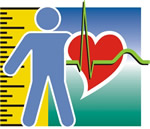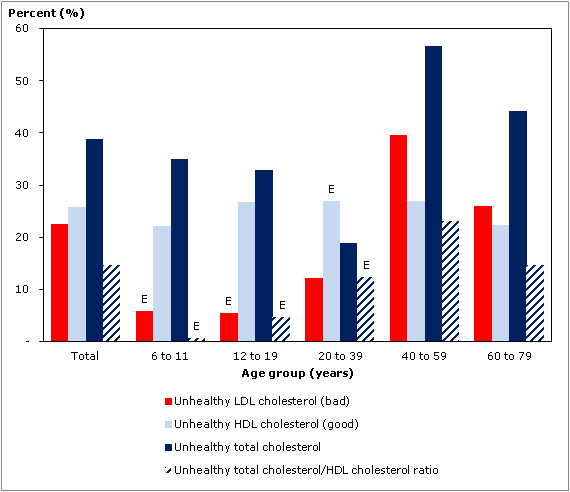Cholesterol levels of Canadians, 2009 to 2011
Archived Content
Information identified as archived is provided for reference, research or recordkeeping purposes. It is not subject to the Government of Canada Web Standards and has not been altered or updated since it was archived. Please "contact us" to request a format other than those available.

Among Canadians aged 6 to 79, 39% had an unhealthy level of total cholesterol. The percentage of Canadians who had an unhealthy level of good cholesterol (23%) did not vary significantly by age group. However, unhealthy levels of bad cholesterol increased significantly with age.
Although cholesterol is essential for human health, high levels of cholesterol in the blood stream can lead to damaged blood vessels and cardiovascular disease. Monitoring cholesterol for the management of abnormal levels and the prevention of cardiovascular diseases is particularly important for males over 40 years of age, as well as menopausal females or females over 50 years of age. People with diabetes and atherosclerosis, or people who have risk factors such as smoking, abdominal obesity, hypertension, or a strong family history of premature cardiovascular disease can also benefit from lipid monitoring and management. The healthy levels of the different types of cholesterol present in the blood are found in Table 1.
| Type of cholesterol | Healthy concentration |
|---|---|
| LDL cholesterol (bad) | < 3.5 mmol/L |
| HDL cholesterol (good) | > 1.0 mmol/L males > 1.3 mmol/L females |
| Total cholesterol | < 4.5 mmol/L (6 to 19 year olds) < 5.2 mmol/L (20 to 79 year olds) |
| Ratio of total cholesterol to HDL cholesterol | < 5.0 |
|
HDL = high density lipoprotein LDL = low density lipoprotein |
|
Cholesterol levels in Canadians
Between 2009 and 2011, unhealthy total cholesterol levels were present in 39% of Canadians aged 6 to 79 years old according to results from the Canadian Health Measures Survey (CHMS) (Chart 1). Among the different age groups, the percentage of Canadians with unhealthy levels of total cholesterol varied significantly, from 35% or less in people under 40 years old, but increasing to 57% and 44% in 40 to 59 year olds and 60 to 79 year olds, respectively. Among people aged 12 and over who had unhealthy total cholesterol levels, only 25% reported having been diagnosed with high cholesterol by a health professional (data not shown).
The number of Canadians with unhealthy LDL (bad) cholesterol levels increased significantly with age, with less than 6% of 6 to 19 year olds having unhealthy LDL cholesterol levels, compared to 12% of 20 to 39 year olds, and 40% of 40 to 59 year olds. However, this number decreased in older adults where 26% of 60 to 79 year olds had unhealthy LDL cholesterol levels. In contrast, no significant difference between age groups was found for unhealthy levels of HDL (good) cholesterol (Chart 1).
The percentage of Canadians with an unhealthy ratio of total cholesterol to HDL cholesterol also varied with age, ranging from 1% for 6 to 11 year olds to 23% for the 40 to 59 (Chart 1).
Chart 1
Percentage of Canadians with unhealthy levels of cholesterol,† by age group, household population aged 6 to 79, Canada, 2009 to 2011

E Use with caution (data with a coefficient of variation from 16.6% to 33.3%)
† Unhealthy levels based on Genest et al.1
Source: Canadian Health Measures Survey, 2009 to 2011. The CHMS directly measures the cholesterol of Canadians aged 6 to 79.
About cholesterol
Cholesterol is vital to human health and well being. It plays an important role in the structure, fluidity and permeability of the cell membrane, and helps synthesize vitamin D and various hormones. Two types of cholesterol exist: good and bad. 'Good' cholesterol is found in blood particles called high density lipoprotein (HDL), it helps prevent the narrowing of artery walls by removing and transporting any excess cholesterol to the liver for excretion.2,3 'Bad' cholesterol is found in low density lipoprotein (LDL) particles. LDL carries the cholesterol from the liver through the entire body and leaves behind any excess on the walls of the arteries. Consequently, 'bad' LDL cholesterol can lead to cardiovascular disease, increasing the risk of heart attacks, strokes, and the necessity for heart bypass surgery.4 The total cholesterol level represents the amount of both HDL and LDL cholesterol. However, the total cholesterol/HDL cholesterol ratio is more indicative of cardiovascular disease.5 The CHMS measured the concentrations of HDL, LDL, and total cholesterol in blood (in millimoles per litre - mmol/L) on a nationally representative fasted population sample.
References
- Genest J, McPherson R, Frohlich J. 2009 Canadian Cancer Society/Canadian Guidelines for the diagnosis and treatment of dyslipidemia and prevention of cardiovascular disease in the adult - 2009 recommendations. Canadian Journal of Cardiology. 2009;10:567-79.
- Castelli W. Cholesterol and lipids in the risk of coronary artery disease - the Framingham Heart Study. Canadian Journal of Cardiology. 1988;4(Suppl A):5A-10A.
- Toth P. When high is low: raising low levels of high-density lipoprotein cholesterol. Current Cardiology Reports. 2008;10:488-96.
- Executive summary of the third report of the National Cholesterol Education Program (NCEP) expert panel on detection, evaluation and treatment of high blood cholesterol in adults (Adult treatment panel III). Journal of the American Medical Association. 2012;285: 2486-97.
- Kappelle P, Gansevoort R, Hillege J, Wolffenbuttel B, Dullaart R. Apolipoprotein B/A-I and total cholesterol/high-density lipoprotein cholesterol ratios both predict cardiovascular events in the general population independently of nonlipid risk factors, albuminuria and C-reactive protein. Journal of Internal Medicine. 2012;269:232-42.
For more information on the Canadian Health Measures Survey, please contact Statistics Canada's National Contact Centre (toll-free 1-800-263-1136; 613-951-8116; infostats@statcan.gc.ca).
- Date modified:
